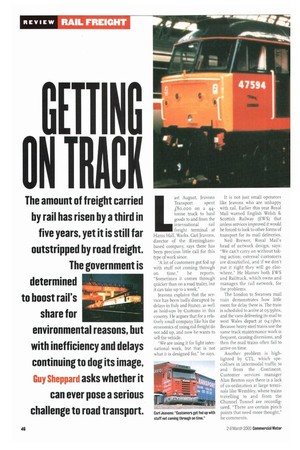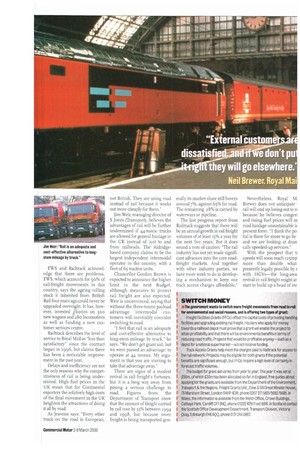GETTING ON TRACK
Page 48

Page 49

If you've noticed an error in this article please click here to report it so we can fix it.
The amount of freight carried by rail has risen by a third in five years, yet it is still far outstripped by road freight.
Last August, Jeavons Transport spent Ego,000 on a 44tonne truck to haul goods to and from the
international rail freight terminal at Hams Hall, Warks. Carl Jeavons, director of the Birminghambased company, says there has been precious little call for this type of work since.
"A lot of customers got fed up with stuff not coming through on time," he reports. "Sometimes it comes through quicker than on a road trailer, but it can take up to a week."
Jeavons explains that the service has been badly disrupted by delays in Italy and France, as well as hold-ups by Customs in this country. I le argues that for a relatively small company like his the economics of using rail freight do not add up, and now he wants to sell the vehicle.
"We are using it for light international work, but that is not what it is designed for." he says.
It is not just small operators like Jeavons who are unhappy with rail. Earlier this year Royal Mail warned English Welsh & Scottish Railway (EWS) that unless services improved it would be forced to look to other forms of transport for its mail deliveries.
Neil Brewer, Royal Mail's head of network design, says: "We can't carry on without taking action; external customers are dissatisfied, and if we don't put it right they will go elsewhere." He blames both EWS and Railtrack, which owns and manages the rail network, for the problems, The London to Swansea mail train demonstrates how little room for delay there is. The train is scheduled to arrive at o3:59hrs, and the vans delivering its mail to west Wales depart at o4:15hrs. Because heavy steel trains use the same track maintenance work is frequent, causing diversions, and then the mail trains often fail to arrive on time.
Another problem is highlighted by CTL. which specialises in intermodal traffic to and from the Continent. Customer services manager Alan Benton says there is a lack of co-ordination at large terminals like Wembley, where trains travelling to and from the Channel Tunnel are reconfigured. "There are certain pinch points that need more thought," he comments. EWS and Rai1track acknowledge that there are problems. EWS, which accounts for 9o% of rail-freight movements in this country, says the ageing rolling stock it inherited from British Rail four years ago could never be upgraded overnight. It has, however, invested L600m on 500 new wagons and 280 locomotives as well as funding a new customer services centre.
Rai1track describes the level of service to Royal Mail as "less than satisfactory" since the contract began in 1996, but claims there has been a noticeable improvement in the past year.
Delays and inefficiency are not the only reasons why the competitiveness of rail is being undermined. High fuel prices in the UK mean that for Continental exporters the relatively high costs of the final movement in the UK heighten the attractions of doing it all by road.
As Jeavons says: "Every other truck on the road is European. not British. They are using road instead of rail because it works out more cheaply for them."
Jim Weir, managing director of S Jones (Transport), believes the advantages of rail will be further undermined if 44-tonne trucks are allowed for general haulage in the UK instead of iust to and from railheads. The Aldridgebased company claims to be the largest independent intermodal operator in the country, with a fleet of 65 tractive units.
Chancellor Gordon Brown is expected to announce the higher limit in the next Budget. although measures to protect rail freight are also expected. Weir is unconvinced, saying that without the three-tonne payload advantage in terrnodal customers will inevitably consider switching to road.
"I feel that rail is an adequate and cost-effective alternative to long-stem mileage by truck," he says. We don't get grant aid, but we were passed an advantage: to operate at 44 tonnes, My argument is that you are starting to take that advantage away."
There are signs of a modest revival in rail freight's fortunes, but it is a long way away from posing a serious challenge to road. Figures from the Department of Transport show that the amount of freight carried by rail rose by 33% between 1994 and 1998, but because more Freight is being transported gen
eraily its market share still hovers around 7%, against 65% for road. The remaining 28% is carried by waterways or pipeline.
The last progress report from Railtrack suggests that there will be an annual growth in rail freight volumes of at least 15% a year for the next five years. But it does sound a note of caution: "The rail industry has not yet made significant advances into the core roadfreight markets. And together with other industry parties, we have more work to do in developing a mechanism to keep our track access charges affordable." Nevertheless, Royal M. Brewer does not anticipate rail will end up losing out to n because he believes congesi and rising fuel prices will no road haulage unsustainable ii present form. "I think the po. tial is there for more to go by and we are looking at drarr cattyspeeded-up services."
With the prospect that ti speeds will soon reach 125mp more than double what presently legaliy possible by r with HGVs—the long-awa revival in rail freight might at start to build up a head of Ste








































































































